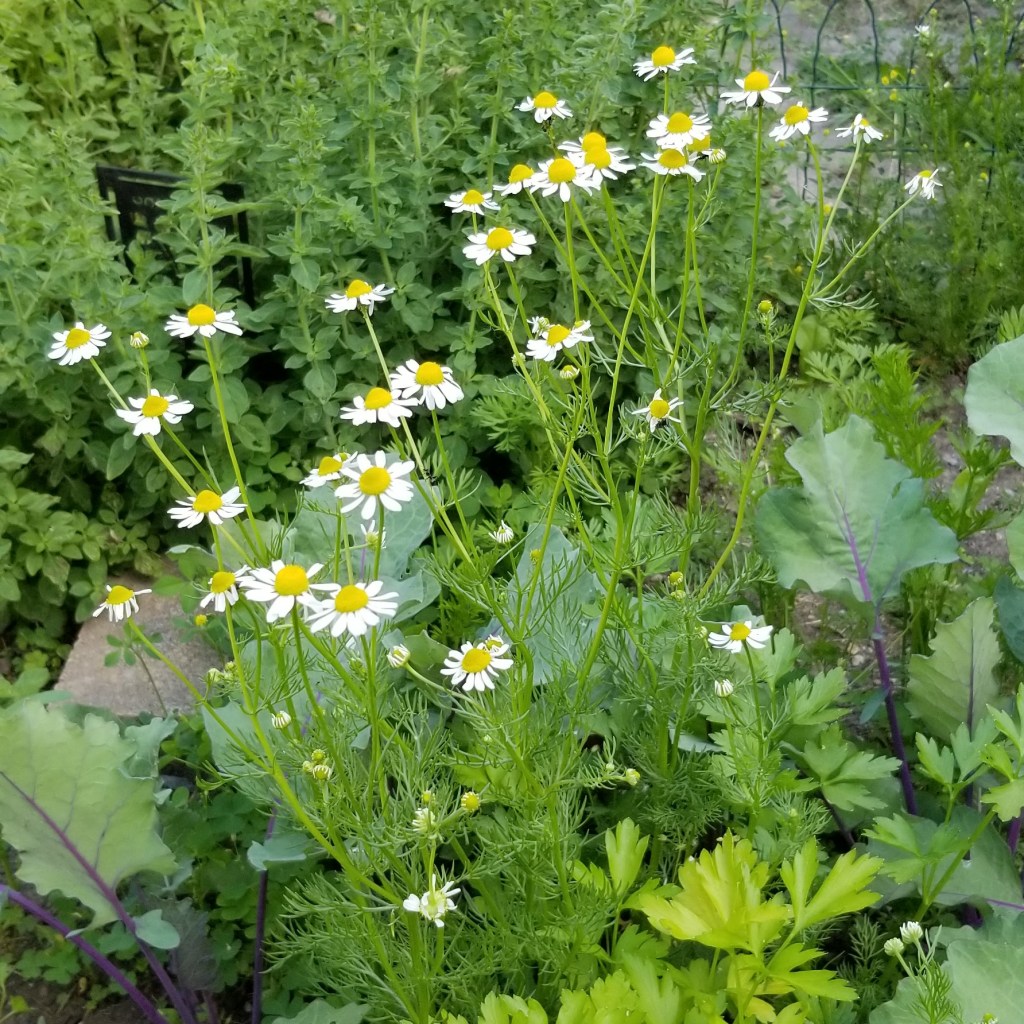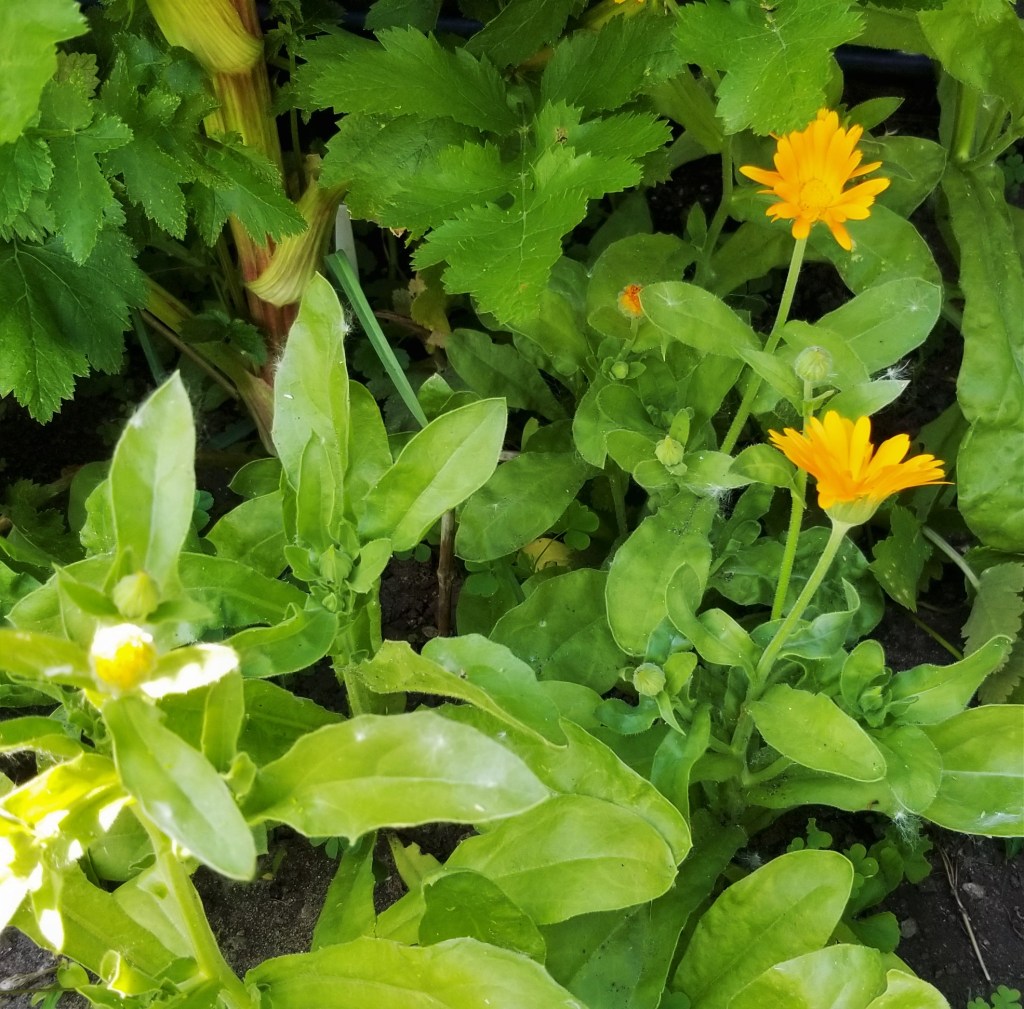
The picture above features an herbal infusion, made with my garden chamomile (Matricaria chamomilla, German chamomile) and pot marigold (Calendula officinalis), along with Maria cookies and cajeta, an old-fashioned Mexican snack. This is a perfect spread for a relaxing mid-afternoon break, to join the Teatime in the blogosphere party, generously hosted by Su @ The Zimmerbitch.
A quick sweep through the garden beds provided the ingredients for my hot beverage:


The ingredients in my infusion are not native to Mexico, and strictly speaking, the title of a “true” tea may be bestowed only upon the beverage, served hot or iced, prepared with leaves and leaf buds from the tea plant, Camellia sinensis, native to Asia. Tea varieties come from differences during processing (oxidation, fermentation, heat treatment), which give way to the well known black and green teas, as well as the more particular white, oolong, pu-erh and yellow teas. The history of tea in the American continent began in the 17th century with the Dutch, importing tea to their colony of New Amsterdam (today’s New York).
My beverage qualifies as an “herbal tea”, or tisane, a term to describe an infusion in hot water of plant parts, such as leaves, but could also be buds, seeds, roots, berries, bark, or as in my case, flowers. Many herbal teas, more appropriately called herbal infusions, were originally concocted as medicinal remedies since olden times, for example Oswego tea, from the beebalm plant (Monarda didyma), well known for its antiseptic properties to the Blackfoot, Winnebago and Oswego native-American nations.
In Mexico, (true) tea was introduced via the USA and thanks to European influence, but there is an ancient tradition of herbal preparations, pre-dating the Spanish conquest. A presentation by Dr. Armando González Stuart, the Herbal Research Coordinator at the Austin Cooperative Pharmacy Program of the University of Texas at El Paso (UTEP) entitled “Plants Used in Mexican Traditional Medicine Traditional Medicine – Their Application and Effects In Traditional Healing Practices” reports that “The Aztec [Mexica] civilization of Mexico was the only one in the New World to record the use of medicinal herbs … Codices containing information about Aztec medicinal plants were considered “heretical”, and burned by Spanish missionaries. A few missionaries had the vision of recuperating at least a small portion of this knowledge and reconstructing two codices; one was written both in Latin and Náhuatl , known as the De La Cruz-Badiano Codex; it became the first bilingual publication of the New World (1552).” Just from gliding through the presentation slides, I learned of several infusions that have been concocted and consumed for centuries in Mexico; here are just three examples from the comprehensive list: 1) Mexican mint marigold (Tagetes lucida Cav.), from the same genus as cempasuchil (Tagetes Erecta, Day of the Dead flower in Mexico) and in the Asteraceae family, the same as pot marigold (Calendula officinalis); an infusion of Mexican mint marigold flowers is known to relieve stomach upset. 2) Bayetilla (Hamelia patens); a leaf infusion administered as tea will combat fever. 3) Capuli (Prunus serotina), known as capolcuahuitl in Nahuatl; an infusion of its leaves and stems proved effective against coughing.
Nowadays, all kinds of teas (true and herbal) are available and well established in the Mexican pantry; some herbal options include: leaves, such as zacate de limón (lemongrass, Cymbopogon citratus) or tila (linden, Tilia sp.); flowers, for example manzanilla (chamomile, Matricaria chamomilla) or flor de jamaica (Hibiscus sabdariffa); bark, for example, canela (cinnamon, Cinnamomum sp.); roots, as for the recently popular equinácea (Echinacea purpurea); fruity ones, such as manzana (apple, Malus domestica); or from seed, the most traditional being anís (anise, Pimpinella anisum).
I am joining The Wonderful Wednesday Blog Hop, graciously hosted by: Ahna @ Hammers ‘n’ Hugs, Bev @ Eclectic red Barn, Cindy @ Simple Steps for Living Life, Emily @ Le Cultivateur, Penny @ Penny’s Passion, Sinea @ Ducks ‘n a Row, Tammy @ My Life Abundant, Tara @ Stilettos and Shiplap, and Denise @ This is my Everybody.








A wonderful trip through tea history, Irene.
LikeLike
Glad you liked it, Tracy!
LikeLiked by 1 person
I like how you broke down which teas came from roots, leaves, flowers, etc. My family often had tea time afterschool– it would always be Red Rose and Mr. Christie’s gingersnaps that were worthy of dunking.
LikeLiked by 2 people
Red Rose, with the Red Rose card in the box! I remember those I still have a small collection of Forest Tree of Canada.
LikeLiked by 2 people
I love reading your posts Irene; I learn so much. I don’t have chamomile in the garden at the moment, but do have plenty of calendula. I also use lemon verbena and lemon balm in tissanes. And thyme is wonderful for coughs.
LikeLike
Thank you, Sue! I don’t have any lemony herbs, I should look into that; I love thyme, too!
LikeLiked by 1 person
I love the taste and scent of lemon, and my herbs grow all year round whereas local lemons are only really available for about six months. I don’t like buying imported lemons because they don’t taste as good, and they travel so far to get here.
LikeLike
We have no local lemons 🙁, but the organic ones from Florida are good.
LikeLiked by 1 person
And not so far to travel!! NZ is pretty remote and so what we do to grow here comes with huge food miles.
LikeLike
Yeah I can imagine.
LikeLiked by 1 person
When I worked at the tea shop, we had quite a lot of tisanes, although people always called them herbal teas. 🙂 I love camomile tea and when I visit my s-i-l in France, there’s a tisane I always buy at the pharmacy in a nearby town. It’s so good and so good for you.
janet
LikeLiked by 1 person
Crushed stems and leaves of Calendula have been used as a poultice to put on bruises and strains. An extract from the stems and leaves was the active ingredient for many years in a concoction called Absorbine Jr.
LikeLike
Oh, good to know. I had never heard of Absorbine Jr.; I wonder where that name came from.
LikeLike
Very educational, Irene. The only thing I’ve ever used from my garden in an infusion is mint. I should look into growing some other items that would make nice herbal “teas.”
LikeLiked by 1 person
It all looks very lovely! 🙂 🙂 What is that spread made of? It looks a bit like Marmite. Savoury, I presume?
LikeLike
Thank you, Jo! The spread is a sweet goat’s milk caramel, traditional in Mexico; if you click on the word “cajeta” you will link to the full description and recipe.
LikeLike
Ah thanks, Irene. Always in too much of a hurry 🤣💕
LikeLiked by 1 person
Gotta live up to your blog’s title LOL 😉
LikeLiked by 1 person